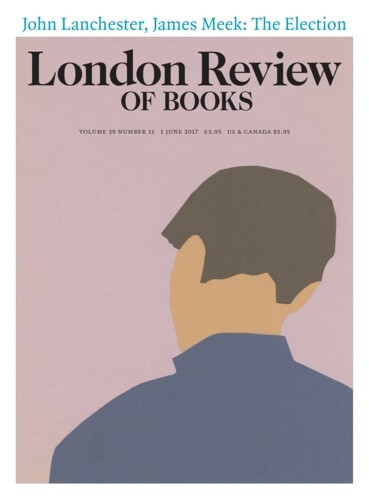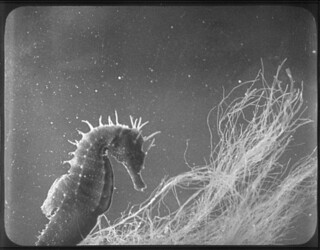Acera bullata is a species of hermaphrodite sea snail or slug, discovered on coasts from Norway to the Mediterranean. It grows up to six centimetres long, has a brown or white shell and a speckled body that may range in colour from grey to orange. In sheltered bays, these molluscs settle into fine, soft mud or muddy sand, where they mate in undulant chains, half a dozen at once. When disturbed from their orgies, the snails swim away using two broad fins or parapodia, which billow around them like skirts or cloaks. In Jean Painlevé’s 1972 documentary film, Acera or the Witches’ Dance, the creatures cavort like weird sisters, twist like slo-mo dervishes, striving upwards in the water and getting nowhere. Towards the end of his study of their lifecycle and movements, Painlevé cuts to a split-second shot of someone moving in the style of Loïe Fuller – the Edwardian dancer who made her name imitating the forms and actions of insects and aquatic animals.
Starting in the mid-1920s, and working as writer, producer, director, editor and narrator, Painlevé made more than two hundred films. The majority are science documentaries – of a sort. Acera or the Witches’ Dance was put on in connection with the Painlevé show at the Ikon gallery in Birmingham, which includes four other films and nine large-format photographs (until 4 June). In his basement studio in Montparnasse, he attached a microscope to his camera and trained it on his aquariums, alternating powerful lights to produce different effects. His amazing array of mostly waterbound beings glows like a troupe of movie starlets, broodingly silhouetted or backlit into transparency. Housing his Debrie camera in a waterproof case, he shot some sequences up to his waist in the Atlantic. There are sea urchins with their spines and hydraulic suckers, a spirograph worm that flings out its delicate fan in another homage to Fuller, a shrimp cleaning itself methodically like a cat with twenty legs. After the Second World War, Painlevé made a film about vampire bats – a bat and its guinea-pig victim stare each other in the face for several minutes before the decisive bite – and turned it into an allegory of Nazi terror. In the 1980s he was still working, filming city pigeons and employing schoolchildren to imitate their head-nodding gait.
At times Painlevé looks like an avant-garde artist and at others like a pioneering documentarist of the natural world: he’s the missing link between the early high-speed and microscopic experiments of Etienne-Jules Marey and Lucien Bull, and the popular adventures of Jacques Cousteau and David Attenborough. In another light Painlevé is a photographic modernist, attending to tiny spines on the rostrum of a shrimp with the abstracting eye that Karl Blossfeldt brought to fiddlehead ferns or László Moholy-Nagy to the geometry of a city street. On the evidence in the Ikon exhibition, he was at once a sedulous describer of minute and alien naturalia, a well-connected amateur of the avant-garde, and a kind of visionary chancer – in the show’s first room there’s a display of brass and Bakelite jewellery he contrived in order to cash in on the success of his film about seahorses.
Painlevé was born in 1902, the son of the mathematician Paul Painlevé, who later served twice as French prime minister. Jean studied medicine, but quit in outrage when he saw the way a hydrocephalic patient was being treated. He switched to marine biology, and while working at the research centre at Roscoff in Brittany met Geneviève Hamon, who became his companion and collaborator. Through her he met Alexander Calder, Jacques Prévert and the photographer Eli Lotar. He became friends with Eisenstein, Buñuel and Jean Vigo. (The severed and preserved hands kept by the old sailor Père Jules in L’Atalante were sourced and supplied by Painlevé.) Among composers, he knew the Futurist Luigi Russolo, Edgar Varèse and later Pierre Henry, whose music he used to score The Love Life of the Octopus in 1965. The pile-up of names is important, because Painlevé seems to have learned from all of them. His films are obsessionally focused on minute anatomy, but aesthetically they invoke everything from Calder’s delicately orbiting abstractions to the ‘organised noise’ of musique concrète. Calder is the subject of the longest film at Ikon, from 1955, where he unpacks the miniature circus he made in the late 1920s, and puts to work the animals and acrobats made of wire and string.
Most often, however, Painlevé has been associated with Surrealism, or at least its dissident varieties. He collaborated with the poet and playwright Ivan Goll on the first and only issue of the journal Surréalisme, which appeared in October 1924. Painlevé had taken a personal dislike to André Breton, and had more in common with Georges Bataille, who reproduced photographs from Painlevé’s film of crabs and shrimps in his journal Documents. A text by Jacques Baron makes the expected connection with Nerval’s pet lobster (‘a gentle animal, affable and clean’); next to it are the appalling close-up heads of the crustaceans. Bataille also reproduced the photograph Lobster Claw, in which the claw, looming out of darkness, resembles a monstrous face. (After the war Painlevé spotted a resemblance and retitled the picture: Lobster Claw or de Gaulle.) The danger of seeing too much in such images is never far away, and Painlevé runs towards it: ‘The most preposterous anthropomorphism reigns in this field.’
His scientific and artistic ambitions are most involuted in L’Hippocampe (The Seahorse), filmed in 1934 in the bay of Arcachon and in Painlevé’s studio. Everything about the seahorse and its milieu is a reminder of something else – the creature’s real medium is metaphor. (Painlevé even gives us seahorses swimming in front of footage of a horse race.) According to the director’s own amused voiceover, a young seahorse resembles a King Charles spaniel. Fully grown, it’s a puffed-up and pompous individual, fretfully anthropoid, given to pouting and anxiously darting its eyes. Like the sea snail, this animal is ambiguously sexed: the female inserts her eggs in the male’s belly, and he squirts out their offspring in gassy contractions. The young attach themselves to a forest of artfully placed weeds: a green world underwater that looks in certain shots like the mise-en-scène of Max Reinhardt’s A Midsummer Night’s Dream, released the following year.
Eisenstein famously admired the protean, boneless characters in early Disney films for their ‘plasmatic’ quality. He had probably picked up the word and idea when he saw Painlevé’s first film, on the eggs of the stickleback. More than whimsical anthropomorphism and Surrealised science, it marks all Painlevé’s work. Figure, substance and form are always ready, materially and visually, to translate (as Peter Quince puts it) into something else altogether; on the way, they will appear alluringly or hideously unformed. At Ikon there are two photographs from Painlevé’s study of the octopus, an animal that can force itself through the smallest apertures, whose colour and texture change constantly, like forest light. Painlevé pushed this interest in labile things to its extreme in his 1978 film, Phase Transition in Liquid Crystals. In response to changes in light and temperature, the magnified crystals throb and scintillate, turning in seconds from brushfires to glaciers, blood cells to nebulae. It’s his most ravishing work: a colour-mad counterpart to Alain Resnais’s 1958 study of plastics production, Le Chant du Styrène.
Though it includes only 2 per cent of his cinematic output, the Ikon exhibition is a considered introduction to Painlevé’s work. If the show scants somewhat his contemporary influence – to mention only French artists, Pierre Huyghe and Aurélien Froment have both made work that invokes his marine imagination – it is clear that he was an artist and educator whose interests overspilled the aquarium to touch design, dance (Balanchine was inspired by his lobsters), mainstream television and experimental film. Even Godard looked at him with wonder: ‘There would not have been a New Wave without Jean Painlevé and his unsinkable camera.’
Send Letters To:
The Editor
London Review of Books,
28 Little Russell Street
London, WC1A 2HN
letters@lrb.co.uk
Please include name, address, and a telephone number.


